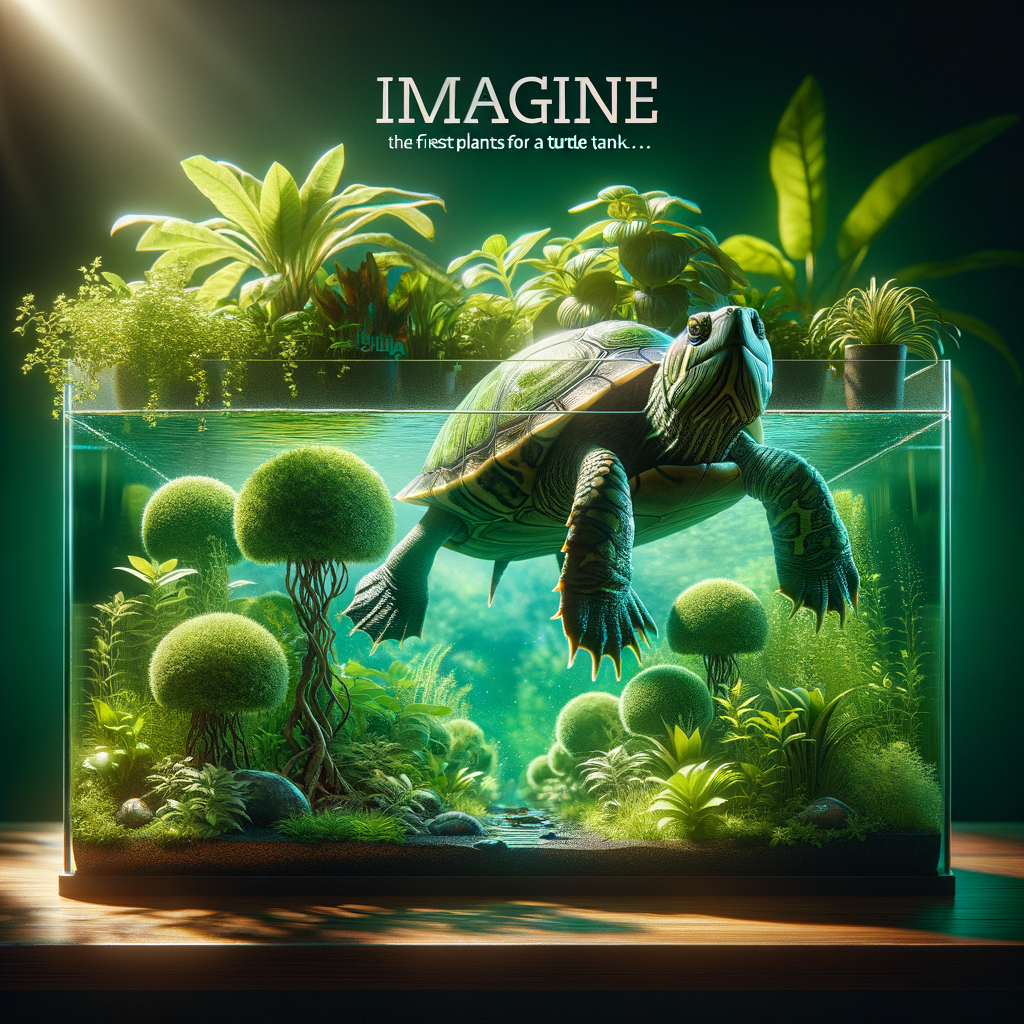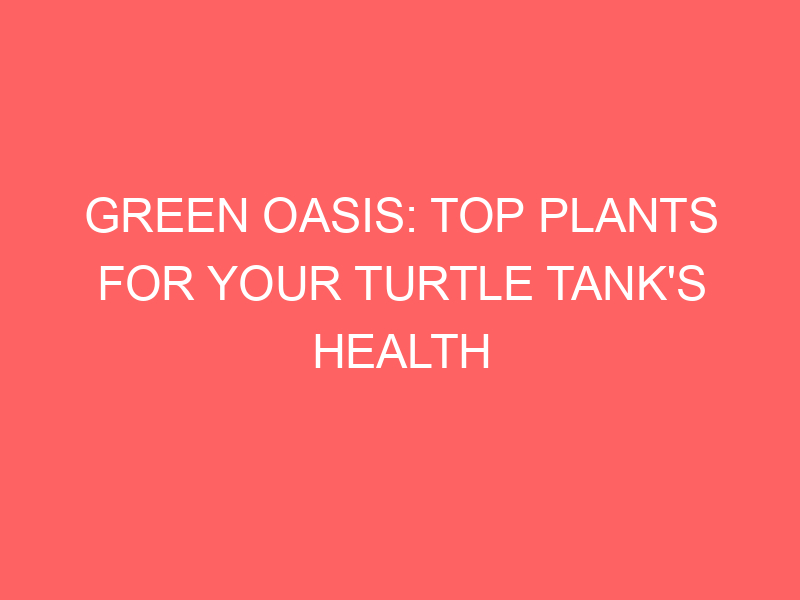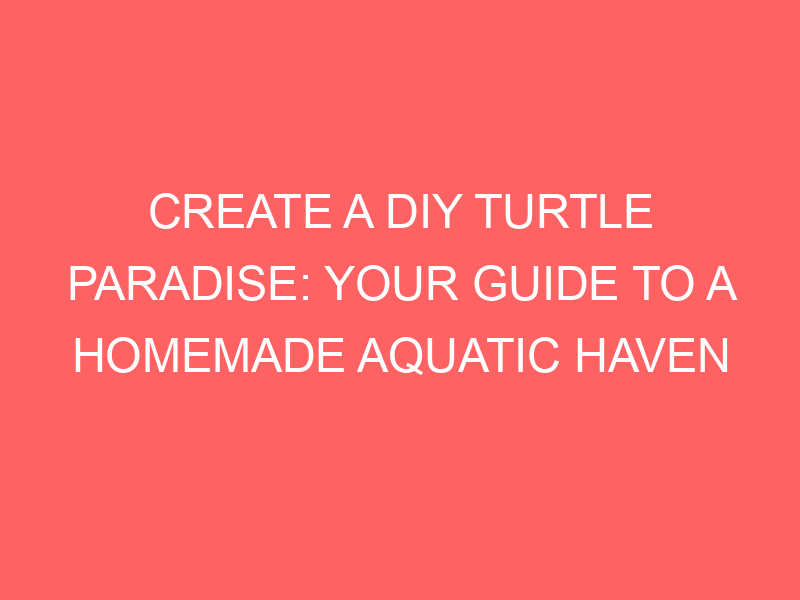
Introduction to Turtle Tank Plants
When setting up a turtle tank, one of the key elements to consider is the inclusion of plants. Plants play a significant role in creating a healthy and natural environment for your turtle. Let’s explore the importance of plants in a turtle tank and the benefits of a natural turtle tank setup.
- Importance of plants in a turtle tank
- Benefits of a natural turtle tank setup
Plants in a turtle tank serve multiple purposes. They not only add aesthetic appeal to the tank but also contribute to the overall health and well-being of your turtle. Plants help to maintain the water quality by absorbing harmful chemicals and providing oxygen. They also offer hiding spots for turtles, making them feel secure and comfortable in their environment.
A natural turtle tank setup, complete with real plants, mimics the turtle’s natural habitat. This setup provides a more enriching and stimulating environment for your turtle, promoting natural behaviors and reducing stress. Additionally, a natural setup helps maintain a balanced ecosystem in the tank, which can reduce the need for frequent water changes and tank cleanings.
In the following sections, we will delve deeper into the best plants for turtle tanks, how to create a healthy turtle tank environment, and how to maintain your turtle’s green oasis. We will also share some successful turtle tank setups to inspire you. So, let’s embark on this journey to build a green oasis for your turtle.
Best Plants for Turtle Tanks: The Green Guardians
Creating a comfortable and natural environment for your pet turtle is essential for its health and happiness. One of the easiest ways to achieve this is by introducing plants into their tank. Not only do plants add a touch of greenery, but they also serve as a source of food, provide hiding spots, and help clean the water. Here are some of the best plants you can consider for your turtle tank.
Types of Ideal Turtle Tank Plants
When choosing plants for your turtle tank, it’s important to select species that are safe for your turtle, easy to maintain, and can thrive in a water-based environment. Here are three top picks:
- Java Fern: A hardy aquatic plant for turtles
- Anubias: A low-maintenance turtle habitat plant
- Water Hyacinth: A floating plant safe for turtles
Java Fern is a popular choice for turtle tanks due to its hardiness. This plant can withstand a variety of water conditions and is not easily damaged by turtles. Its broad leaves provide excellent cover and resting spots for your pet.
Anubias is another excellent choice for turtle tanks. This plant requires minimal light and care, making it perfect for busy turtle owners. Its thick leaves and sturdy structure can withstand the active lifestyle of turtles.
Water Hyacinth is a floating plant that turtles love. It provides a great platform for turtles to bask on, and its roots offer a natural feeding ground for them. However, this plant can grow rapidly, so regular trimming may be necessary to prevent it from taking over the tank.
Remember, the best turtle tank setup is one that mimics your pet’s natural habitat as closely as possible. By incorporating these plants into your turtle tank, you can create a green oasis that your turtle will love and thrive in.
Creating a Healthy Turtle Tank Environment
Creating a healthy environment for your turtle involves more than just filling a tank with water. It’s about creating a habitat that mimics their natural environment. One of the key elements in achieving this is the strategic placement of plants in the turtle tank.
Placement of Plants in a Turtle Tank
Plants play a crucial role in a turtle’s environment. They provide hiding spots, contribute to the tank’s aesthetics, and help maintain the water quality. However, the placement of these plants is equally important. Here are some tips on how to place plants in a turtle tank:
- Creating hiding spots with turtle tank vegetation: Turtles are shy creatures and often need a place to hide. Placing plants in strategic locations can create natural hiding spots. For instance, you can place taller plants at the back of the tank and smaller ones in the front. This arrangement not only creates a depth perception but also provides ample hiding spaces for your turtle.
- Ensuring proper light for aquatic plants for turtles: Aquatic plants require adequate light to thrive. However, too much light can lead to the growth of algae, which can harm your turtle. Therefore, it’s important to strike a balance. Place your tank in a location that receives indirect sunlight and consider using a UVB light. This ensures that your plants get the light they need without promoting algae growth.
In conclusion, the placement of plants in a turtle tank can significantly impact the health and happiness of your turtle. By creating hiding spots and ensuring proper light for the plants, you can create a thriving environment for your pet.
Maintaining Your Turtle’s Green Oasis
Keeping a turtle tank clean and green is not just about aesthetics. It’s about creating a healthy and stimulating environment for your pet turtle. In this section, we will explore how to maintain the greenery in your turtle’s tank.
Caring for Your Turtle Tank Plants
Plants in a turtle tank serve multiple purposes. They provide shelter, contribute to the tank’s filtration system, and even serve as a food source for some turtle species. However, they require proper care to thrive. Here are some steps you can take:
- Regular pruning of turtle tank plants
- Replacing plants in a turtle tank
Just like plants in your garden, those in your turtle tank need regular pruning. This helps to control their size, keep them healthy, and prevent them from taking over the tank. Pruning involves removing dead or dying leaves and stems, which can otherwise decay and pollute the water. It’s best to use a pair of sharp, clean scissors for this task. Remember to be gentle to avoid damaging the plants or disturbing your turtle.
Despite your best efforts, some plants may not thrive in the tank environment. If a plant is continually wilting or dying, it may be best to replace it. When choosing a new plant, consider factors such as the plant’s light and temperature requirements, as well as its compatibility with your turtle species. Always rinse new plants thoroughly before introducing them to the tank to remove any pesticides or other harmful substances.
In conclusion, maintaining the greenery in your turtle’s tank involves regular pruning and, if necessary, replacing plants. With these steps, you can ensure that your turtle’s green oasis remains healthy and vibrant.
Case Studies: Successful Turtle Tank Setups
Let’s take a look at some real-life examples of successful turtle tank setups. These case studies will provide you with practical insights and ideas for your own turtle tank.
Example 1: A Balanced Aquatic Environment
In this first example, the turtle tank owner successfully created a balanced aquatic environment for their turtle. They did this by using a variety of different types of turtle habitat plants.
- Use of Different Types of Turtle Habitat Plants: The owner used a mix of both floating and submerged plants. Floating plants, like water lettuce and duckweed, provided shade and hiding spots for the turtle. Submerged plants, like anacharis and java fern, helped to oxygenate the water and provide additional food sources. This variety not only made the tank visually appealing but also catered to the turtle’s natural instincts and needs.
- Benefits Observed in Turtle Health and Behavior: After introducing these plants, the owner noticed significant improvements in the turtle’s health and behavior. The turtle became more active and displayed natural behaviors like basking and foraging. The turtle’s shell also became healthier and shinier, indicating good overall health. This case study shows how a well-planned plant setup can greatly enhance a turtle’s quality of life.
In conclusion, this case study demonstrates the importance of using a variety of turtle habitat plants to create a balanced and natural environment. Not only does it make the tank more attractive, but it also promotes healthier and more natural behavior in turtles.
Example 2: Overcoming Challenges in Plant Maintenance
Keeping a turtle tank healthy and vibrant is not always a walk in the park. There are challenges that come with maintaining certain types of turtle tank vegetation. Let’s delve into some of these issues and how they can be overcome.
- Issues faced with certain types of turtle tank vegetation
- Solutions and key takeaways
Some plants, like the Amazon Sword and Anubias, are quite popular in turtle tanks. However, they often face issues such as overgrowth, which can limit swimming space for the turtles. Other plants may not be able to withstand the turtles’ nibbling, leading to their rapid deterioration. Furthermore, some plants may not thrive in the water conditions of a turtle tank, causing them to wilt and die, leading to a less appealing and unhealthy environment for the turtles.
Overcoming these challenges requires a keen understanding of both the plant and turtle species in your tank. For overgrowth issues, regular pruning can help keep the plants in check. If your turtles are voracious eaters, consider adding hardy plants like Java Ferns that can withstand their nibbling. For plants that are not thriving, it’s essential to research and choose plants that are compatible with your turtle’s water conditions. Remember, a healthy turtle tank is a balance of the right plants, proper maintenance, and happy turtles.
Here is a summary of the key takeaways:
| Issue | Solution |
|---|---|
| Plant Overgrowth | Regular Pruning |
| Turtles Eating Plants | Add Hardy Plants like Java Ferns |
| Plants Not Thriving | Choose Plants Compatible with Water Conditions |
In conclusion, overcoming challenges in plant maintenance is all about understanding the needs of both your turtles and the plants. With the right knowledge and a bit of effort, you can create a thriving green oasis for your turtles to enjoy.
Conclusion: Building Your Turtle’s Green Oasis
As we draw to a close, let’s take a moment to reflect on the key points we’ve learned about creating a thriving green oasis for your turtle. With the right plants and a healthy environment, your turtle tank can become a vibrant ecosystem that your pet will love.
- Recap of the best plants for turtle tanks
- Final thoughts on creating a healthy turtle tank environment
We’ve explored a variety of plants that are ideal for turtle tanks. These include the Anubias, Java Fern, and Amazon Sword Plant, all of which are known for their hardiness and ability to thrive in a turtle’s environment. We also discussed the importance of choosing plants that are non-toxic and safe for your turtle to nibble on.
Creating a healthy environment for your turtle goes beyond just selecting the right plants. It’s about maintaining the right temperature, ensuring clean water, and providing a balanced diet. Remember, a healthy turtle is a happy turtle!
Building your turtle’s green oasis is a rewarding task that not only enhances the aesthetic appeal of your home but also contributes to the well-being of your pet. With the right knowledge and a bit of patience, you can create a turtle tank that is both beautiful and beneficial.
As the famous zoologist, George Schaller once said, “In the end, we will conserve only what we love; we will love only what we understand; and we will understand only what we are taught.” So, let’s continue to learn and create better habitats for our beloved pets.














